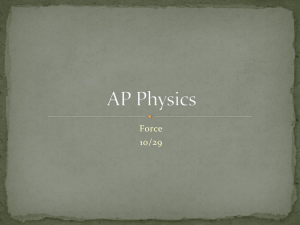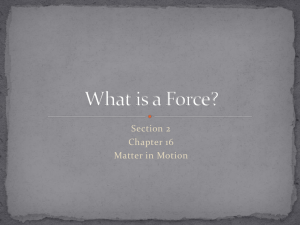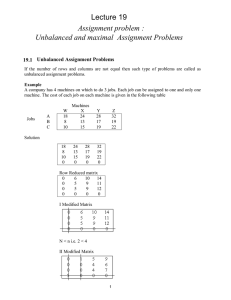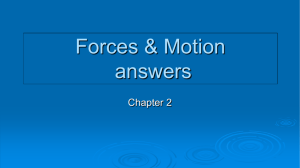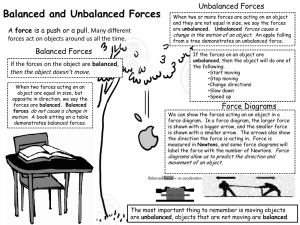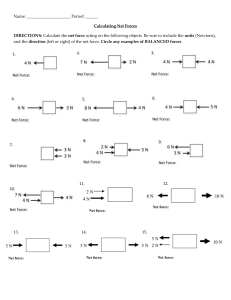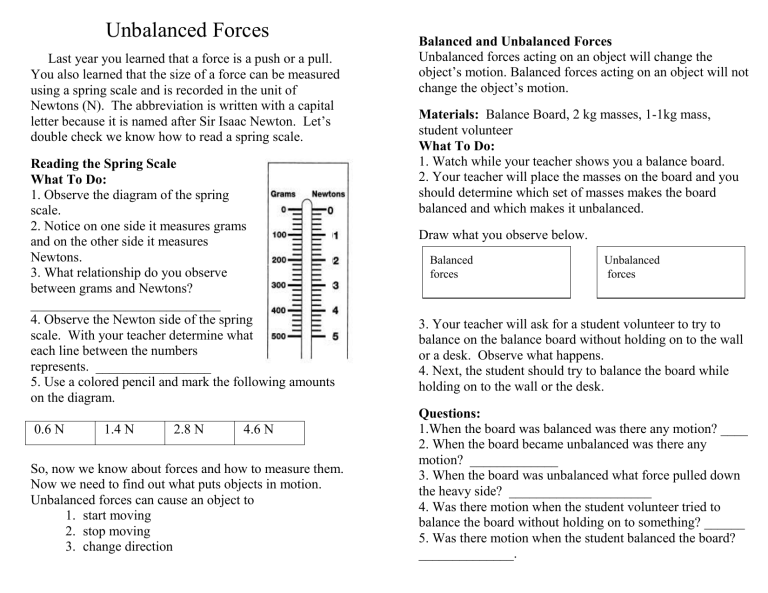
Unbalanced Forces Last year you learned that a force is a push or a pull. You also learned that the size of a force can be measured using a spring scale and is recorded in the unit of Newtons (N). The abbreviation is written with a capital letter because it is named after Sir Isaac Newton. Let’s double check we know how to read a spring scale. Reading the Spring Scale What To Do: 1. Observe the diagram of the spring scale. 2. Notice on one side it measures grams and on the other side it measures Newtons. 3. What relationship do you observe between grams and Newtons? ____________________________ 4. Observe the Newton side of the spring scale. With your teacher determine what each line between the numbers represents. _________________ 5. Use a colored pencil and mark the following amounts on the diagram. 0.6 N 1.4 N 2.8 N 4.6 N So, now we know about forces and how to measure them. Now we need to find out what puts objects in motion. Unbalanced forces can cause an object to 1. start moving 2. stop moving 3. change direction Balanced and Unbalanced Forces Unbalanced forces acting on an object will change the object’s motion. Balanced forces acting on an object will not change the object’s motion. Materials: Balance Board, 2 kg masses, 1-1kg mass, student volunteer What To Do: 1. Watch while your teacher shows you a balance board. 2. Your teacher will place the masses on the board and you should determine which set of masses makes the board balanced and which makes it unbalanced. Draw what you observe below. Balanced forces Unbalanced forces 3. Your teacher will ask for a student volunteer to try to balance on the balance board without holding on to the wall or a desk. Observe what happens. 4. Next, the student should try to balance the board while holding on to the wall or the desk. Questions: 1.When the board was balanced was there any motion? ____ 2. When the board became unbalanced was there any motion? _____________ 3. When the board was unbalanced what force pulled down the heavy side? _____________________ 4. Was there motion when the student volunteer tried to balance the board without holding on to something? ______ 5. Was there motion when the student balanced the board? ______________. Several forces can combine to make a total, or net, force. More than one force can act on an object at once. For example, two people could pull on a rope at the same time. One person could pull toward the left and the other could pull toward the right. These forces are acting in opposite directions so we must subtract the smaller force from the larger force. Then the rope moves in the direction of the larger force. 1. What is the net force pulling on the rope below? ________ 2. Which direction will the rope move? _____________ Or it could be one person pushing on a No math needed there. 3. What is the net force pushing on the box? ___________ 4. Which direction will it move? ___________________ box. 10 N What if 2 people were pushing in the same direction? 5. The first person is pushing with 25 N and the second person is pushing with 20 N. What will be the net force on the box? (Hint: You must add the forces together.) __________ Net Forces Materials: Net Forces Cards What To Do: 1. Look at the cards you and your partner have been given. 2. Place the 5 “word” cards on your table. 3. Look at the “forces” cards, calculate the net force and place them in the correct categories found on the word cards. Questions: 1. Which “forces” cards belong in the category Moves Up? ________________________________ 2. Which “forces” cards belong in the category Moves Down? ______________________________ 3. Which “forces” cards belong in the category Moves Left? _______________________________ 4. Which “forces” cards belong in the category Moves Right? ______________________________ 5. Which “forces” cards belong in the category Stays Still? ________________________________ 6. Are the forces balanced or unbalanced on card A? ______ 7. Will the box on card A move? ______________ 8. Are the forces balanced or unbalanced on card B? _______ 9. Will the box on card B move? _____________ 10. Which type of force makes objects move? __________ As we just read unbalanced forces can cause an object to start moving, stop moving or change direction. What will happen to the boxes below? In the space below, draw the box and forces to show the motion indicated. Box moving to the right Box moving to the left Box changing direction As we just read unbalanced forces can cause an object to start moving, stop moving or change direction. What will happen to the boxes below? In the space below, draw the box and forces to show the motion indicated. Box moving to the right Box moving to the left Box changing direction Name _______________ period ____ Name _______________ period ____ EXIT TICKET EXIT TICKET Unbalanced Forces Unbalanced Forces 1. What is the net force acting on this box? _____________ 1. Which of the following does not happen when dealing with unbalanced forces? 6N A. Objects start moving B. Objects don’t move 2. In which direction will the box move? __________________ 3. Are the forces balanced or unbalanced? _______________ 4. Which of the following does not happen when dealing with unbalanced forces? A. Objects start moving B. Objects don’t move C. Objects stop moving D. Objects change direction 5. Draw a box that shows forces acting on ir that causes it to move to the right. C. Objects stop moving D. Objects change direction 2. What is the net force acting on this box? _____________ 3. In which direction will the box move? __________________ 4. Are the forces balanced or unbalanced? _______________ 5. Draw a box that shows forces acting on it that causes it to move to the left. 6N
